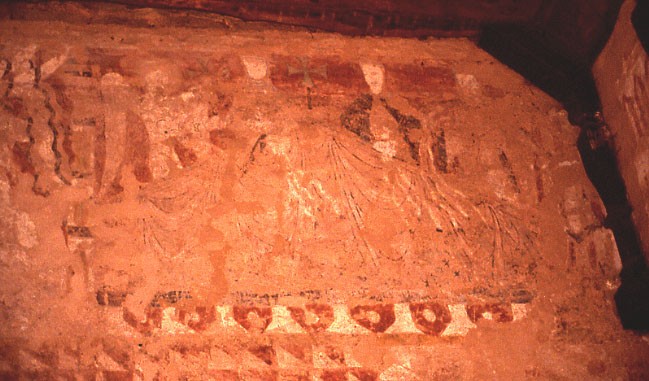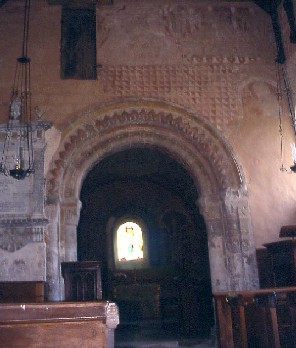Kempley, Gloucestershire c.1180
The Three Marys at the Sepulchre

Apart from some very indistinct remains of a companion subject on the north side of the chancel arch, this, on the south side, is now the only 12th century painting left in the nave of the church. It is contemporary with the paintings in the chancel at Kempley.
At the far left are some wavy and approximately vertical lines in black and red, and to the right of these is the faint and incomplete outline of an angel, shown upright as if standing and in sharp profile. This must be one of the angels encountered by the women when they went to the sepulchre to anoint Christ’s body – a comparison with the various angels and Evangelist symbols in the chancel paintings will confirm the very close similarities, especially in the shape of the wings. Another angel might once have been at the far right. To the right of this visible one are the three Marys¹ – three faint figures whose lower bodies are obscured by what seems to be a great tent-like swathe of swagged drapery with (again apparently) the top of a cross on a long shaft at the apex.
This cross is, I think, likely to be of a later date and nothing to do with this scene. Whether this also applies to the drapery is harder to decide. It looks contemporary with the Three Marys, but its loops and swags obscure the broad horizontal border, outlined in dark grey, that divides this zone of the wall from the area below, where there is a further border with red hollow circles on a white ground, and below that an obscure figure and an area of shaded chequerboard tesselation (these details are pictured at the bottom of the page). Moreover, it is hard to believe that having painted these hieratic, ‘processional’ figures, a painter would then mask them with this kind of decorative detail, unless it has some elusive symbolic significance. One such possibility, although it does not seem to me very likely, is that it is intended as a veil drawn over the sepulchre itself, concealing the mystery of the Resurrection. But when the paintings at Kempley were discovered in 1872, there were various layers of painting on the nave walls, most markedly on the south wall, but elsewhere as well. The simplest explanation – that this drapery is a later overlay, might well be the correct one. Painted draperies from virtually all periods feature in the English parish church, and on this site Martley has an example.
The Three Marys at the Sepulchre is now very rare indeed, but in the 12th and 13th centuries it was probably much more popular than the surviving evidence suggests. For one thing, it has specific connections to liturgy and the beginnings of medieval drama via the ‘Quem quaeritis?’² trope, the question and answer that from the tenth century on preceded the celebration of Mass on Easter Day.
Another probable Three Marys is part of the Passion Cycle at Amberley in Sussex. Two more forthcoming from Sussex are Hardham, very faint but even earlier than Kempley, and West Chiltington, equally faint but of the thirteenth century. There is what is probably another example, much clearer and 14th century in date, at Belchamp Walter in Essex. Winterbourne Dauntsey, in Wiltshire, once had a remarkably clear painting of the subject, but it now survives only as a drawing (Plate 72) in Tristram’s 13th century volume³


Left: Unidentified figure under illusionistic arch.
Right: The chancel arch wall, showing the tesselated pattern and this figure.
The latter is almost certainly contemporary with the Three Marys and the chancel paintings, where the detail on the illusionistic arches is very similar. The patterned area might be later.
¹ Mary Magdalene, Mary the mother of James and (Mary) Salome. Only Mark (16:1) names all three, but all four Gospels relate the incident.
² Interrogatio. “Quem quaeritis in sepulchro, o Christicolae?” Responsio. “Jesum Nazarenum crucifixum, o caelicolae. Angeli. Non est hic; surrexit, sicut praedixerat. Ite, nuntiate quia surrexit de sepulchro”. [Question (Angel). “Whom do ye seek in the sepulchre, O followers of Christ?” Answer (Marys). “Jesus of Nazareth, who was crucified, O heavenly ones.” Angel. “He is not here: he is risen, just as he foretold. Go, announce that he is risen from the sepulchre”]. The Quem quaeritis, originally part of the liturgy, became an acted-out piece of dialogue, with one speaker representing the Angel and three others who approach him as if seeking something. It developed over time, losing its connection with the Mass and drawing various non-Biblical additions, such as a scene of the Marys buying the spices for the anointing, round it.
³ EW Tristram, English Medieval Wall Painting: The Twelfth Century, Plates, Vol 1, Plate 72 [see Bibliography]